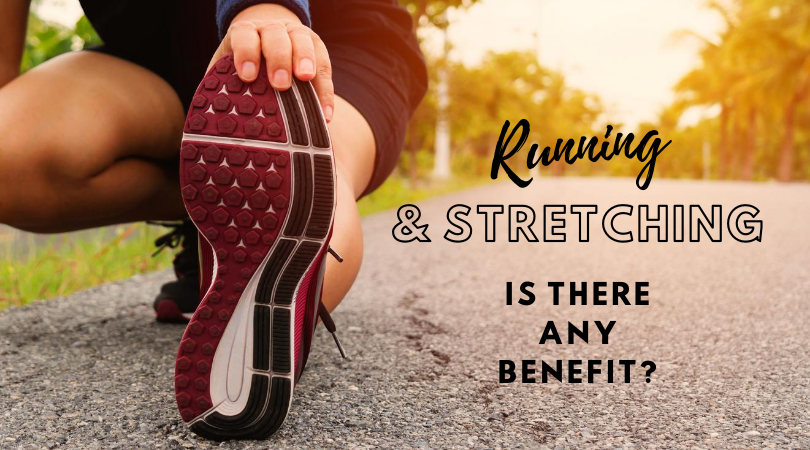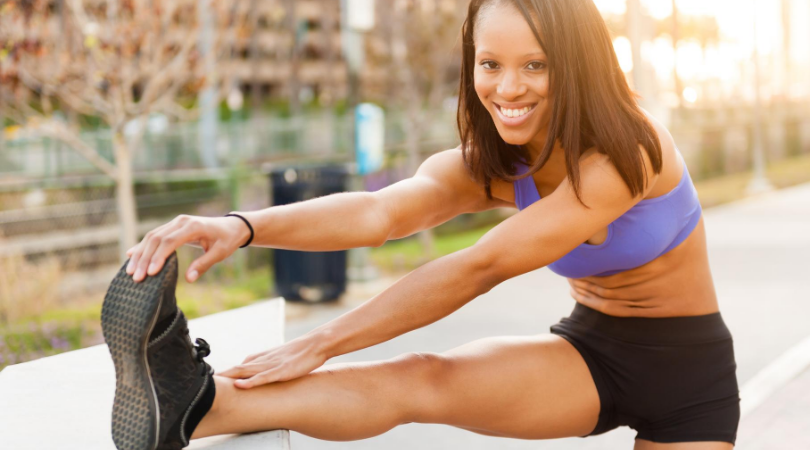Running & Stretching: Is there any benefit?

It fascinates me the variation between individuals running and stretching. Some will put on their shoes and break-out into their jog while others spend 10-15 minutes stretching before and after. Is one preparation better than the other? Are we putting ourselves at risk if we don’t stretch? There are often misconceptions around static stretching and I’ll often hear comments like “I hate stretching before a run but it’s very important” or “I’m always injured because I don’t stretch”. So let’s clear a few things up.
Running & Static Stretching
I believe runners shouldn’t get caught up in static stretches if the body doesn’t feel the need to do so. Static is the ‘stretch & hold’ type & doesn’t hold a lot of weight when it comes to preparing your body for running. For me this makes sense. The body doesn’t go through extreme ranges of movement when running like a dancer or a gymnast would. This is backed up with scientific guidelines that suggest you should only do light static stretches right before a run if tight joints & muscles are negatively impacting your stride function. In other words, your ‘biomechanics’. While this seems like a sensible statement, the vast majority of runners will not require such preparation and the muscles will be ready for the range of movement required if you were to run straight away.

Stretching & Running Injuries
Studies such as Baxter et al 2016 have compiled large amounts of literature and found that the majority of studies suggest stretching has no impact on the risk of chronic injuries in endurance runners. This includes injuries such as illiotibial band friction syndrome, achilles tendinopathy and plantar fasciitis. It has shown that long-term stretching can potentially increase the compliance of the muscle–tendon unit and may allow greater force production at longer muscle lengths (McHugh & Nesse, 2008) which may be relevant to other sporting disciplines; however, for endurance running these potential benefits are not clinically beneficial. With this statement in mind, it seems that activities requiring a greater force production like dunking a basketball or quickly changing direction may have some benefit to stretching. However, running does not require such high demands on the body.
Stretching for recovery after running
Another seemingly beneficial effect of static stretching is recovery. However, High et al. (1989) conducted a study that investigated the effect of stretching on delayed onset muscle soreness (DOMS) of 62 healthy participants in order to investigate these claims. There was a static stretching group and a control group (no stretching) and the results demonstrated that there was no significant difference between muscle soreness over the following 5 days. These findings were supported by a number of additional studies, including Herbert et al. (2011) who reported there was no evidence suggesting static or dynamic stretching performed before or after exercise had the ability to reduce the severity or duration of DOMS.

Stretching for certain injuries
ITB Stretching
ITB friction syndrome is due to an overload usually from increased training and certain biomechanical factors. I recorded a podcast episode all about ITB friction sysndrome on the Run Smarter Podcast. But the bottom line, ITB friction syndrome is not due to ITB tightness, and stretching the thick ITB fascia cannot lengthen its properties. A fantastic article on ITB stretching can be found at the Pain Science website here.
Patellofemoral pain
When I was training to be a physiotherapist in 2012, I was taught that the floating patella (kneecap) was manipulated by muscle tightness & muscle weakness. It only made sense to stretch the ‘tight’ muscles while strengthening the weak muscles. Well, current evidence now directs the cause of patellofemoral pain to ‘overload’. Therefore, strengthening the entire knee to tolerate higher loads, while maintaining a healthy running program now seems the more effective approach. For more information you can listen to this podcast episode on all things runners knee.
High hamstring tendinopathy
Correct management of a high hamstring tendinopathy is to treat it like an insertional tendinopathy. This is similar to an insertional Achilles tendinopathy. Therefore, we need to avoid ‘compression’ during a state of high irritation. Stretching the hamstring is one way to cause compression. In other words, stretching makes this condition worse! For more information on this topic head to Common Mistakes a runner makes with their hamstring rehabilitation.
Plantar fasciitis
The effects of stretching for plantar fasciitis can vary from runner to runner. For some, it can provide temporary relief. However, evidence directs long-term management towards loading. With randomised control trials (RCTs) favoring strengthening over stretching for plantar fasciitis treatment.

When SHOULD runners stretch?
I don’t want this article to oppose stretching. However, we do need to get our facts straight and not be misguided with the effects of stretching. So let’s finish on a positive note with some points on when a runner should stretch.
- IF IT FEELS GOOD! You should stretch, get a massage, use a foam roller if it feels good. Personally, I like to stretch for 5-10 seconds for each muscle group before I leave the house for a run because I know it makes me feel better and more prepared. For others it may be less, it may be more. However, if you are suffering from a tendinopathy that is irritated from compression, stretching may momentarily feel good but is not advised.
- If you are within the very small percentage of runners who have altered biomechanics without stretching. To which, gentle dynamic stretches will suffice. Masters runners over the age of 50 may benefit from stretching and a lot of professionals advise older runners to start prioritizing stretches. For more on masters runners listen to this podcast episode Survive & thrive as a masters runner with Matt Walsh
- Potentially for high power based workouts. Runners will often hit the gym. Do HIIT classes and mix up their running with strides or hill workouts. These scenarios may require greater range of movement and the routine to prepare the body needs to factor in. A dynamic warm-up may be more effective than static stretching but will still offer benefits.
So continue stretching if you wish, just make sure it is accompanied with the correct intentions. Good luck!
Relevant Podcast Episodes:
Relevant Blogs:
- Why stretching won’t help muscle tightness
- Understanding muscle cramping
- Pain Science Blog on Stretching
